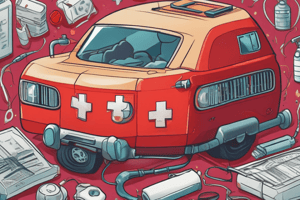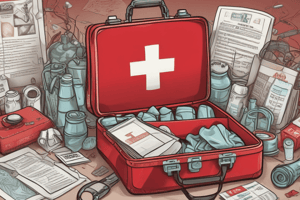Podcast
Questions and Answers
Which of the following is NOT a primary objective of first aid?
Which of the following is NOT a primary objective of first aid?
- To alleviate suffering
- To prolong life
- To compete with services of a physician (correct)
- To save lives
It is acceptable to give an unconscious person food or drink during first aid.
It is acceptable to give an unconscious person food or drink during first aid.
False (B)
What does the acronym 'CAB' stand for in the primary survey?
What does the acronym 'CAB' stand for in the primary survey?
Circulation, Airway, Breathing
A good first aider must be _____, noticing all signs of injury or illness.
A good first aider must be _____, noticing all signs of injury or illness.
Match the characteristic of a good first aider with its description:
Match the characteristic of a good first aider with its description:
What should you do first if you are at an emergency scene?
What should you do first if you are at an emergency scene?
Moving an injured person is always the best course of action during first aid.
Moving an injured person is always the best course of action during first aid.
First aid should be provided until the services of a ______ begin.
First aid should be provided until the services of a ______ begin.
What does the acronym RICE stand for in the context of first aid?
What does the acronym RICE stand for in the context of first aid?
A secondary survey is performed before a primary survey.
A secondary survey is performed before a primary survey.
What is the main cause of heat cramps?
What is the main cause of heat cramps?
A _ is a break in the bone.
A _ is a break in the bone.
Which of the following is NOT a recommended first aid step for strains?
Which of the following is NOT a recommended first aid step for strains?
For a dislocation, it is recommended to try to move the bone back into its normal position.
For a dislocation, it is recommended to try to move the bone back into its normal position.
What should you provide for a person experiencing heat cramps?
What should you provide for a person experiencing heat cramps?
Match the following injuries with their descriptions:
Match the following injuries with their descriptions:
What is the recommended action for a victim of heat exhaustion regarding clothing?
What is the recommended action for a victim of heat exhaustion regarding clothing?
In cases of heatstroke, vomiting indicates the victim is recovering and should not cause concern.
In cases of heatstroke, vomiting indicates the victim is recovering and should not cause concern.
What is the first step in controlling bleeding?
What is the first step in controlling bleeding?
For ingested poisons, if the victim is conscious, ask what was swallowed, how much, and ______.
For ingested poisons, if the victim is conscious, ask what was swallowed, how much, and ______.
Match the first aid actions to the type of poisoning:
Match the first aid actions to the type of poisoning:
What position should a victim with heat exhaustion be placed in?
What position should a victim with heat exhaustion be placed in?
For injected poison from an animal bite, it is best to leave the animal near the victim to possibly get identified later.
For injected poison from an animal bite, it is best to leave the animal near the victim to possibly get identified later.
What is the recommended length of time to wash a victim with absorbed poison?
What is the recommended length of time to wash a victim with absorbed poison?
What is the first step in providing first aid for a heart attack?
What is the first step in providing first aid for a heart attack?
When providing first aid for a burn, it is recommended to touch the injured area to assess the severity.
When providing first aid for a burn, it is recommended to touch the injured area to assess the severity.
What does C.A.B stand for in the context of first aid?
What does C.A.B stand for in the context of first aid?
In the first aid for drowning, help the victim lie down with the head ______ than the rest of the body.
In the first aid for drowning, help the victim lie down with the head ______ than the rest of the body.
Match the first aid scenario with the correct first step:
Match the first aid scenario with the correct first step:
Flashcards
First Aid
First Aid
Immediate and temporary care given to a person who suddenly gets ill or injured. It includes self-help and home care if medical assistance is not available or delayed.
Primary Survey (C.A.B)
Primary Survey (C.A.B)
A procedure used for unconscious victims to quickly identify and treat life-threatening conditions. Involves checking for Consciousness, Airway, Breathing and Circulation.
Life-threatening Condition
Life-threatening Condition
An emergency that requires immediate medical attention to prevent further injury or death.
Shock
Shock
Signup and view all the flashcards
Assessing the Situation
Assessing the Situation
Signup and view all the flashcards
Resourcefulness
Resourcefulness
Signup and view all the flashcards
Roles of First Aid
Roles of First Aid
Signup and view all the flashcards
Objectives of First Aid
Objectives of First Aid
Signup and view all the flashcards
Sprain
Sprain
Signup and view all the flashcards
Fracture
Fracture
Signup and view all the flashcards
Strain
Strain
Signup and view all the flashcards
Dislocation
Dislocation
Signup and view all the flashcards
Heat Cramps
Heat Cramps
Signup and view all the flashcards
Heat Stroke
Heat Stroke
Signup and view all the flashcards
Heat Exhaustion
Heat Exhaustion
Signup and view all the flashcards
RICE
RICE
Signup and view all the flashcards
Choking
Choking
Signup and view all the flashcards
Heart Attack
Heart Attack
Signup and view all the flashcards
Burn
Burn
Signup and view all the flashcards
Drowning
Drowning
Signup and view all the flashcards
Abdominal Thrusts
Abdominal Thrusts
Signup and view all the flashcards
Controlling Bleeding
Controlling Bleeding
Signup and view all the flashcards
Poisoning
Poisoning
Signup and view all the flashcards
Study Notes
Health 9 - Quarter 3: Emergency Procedures and First Aid
- Emergency Situations: Students should be prepared to respond to scenarios such as a person hit by a car, a teacher having a heart attack, a mother touching a hot pan, and a baby swallowing a toy.
First Aid
- Definition: Immediate, temporary care for a person who suddenly becomes ill or injured. It includes self-help and home care if professional medical help isn't immediately available or if there's a delay.
Roles of First Aid
- Bridge: Connects the victim with medical personnel, filling the gap between those roles.
- Limited Scope: Primarily meant as initial help, not meant to replace physician services.
- Time Limit: Ends when professional medical help begins.
Objectives of First Aid
- Save Lives: The most important objective is safeguarding the victim's life.
- Prolong Life: Sustaining life through emergency procedures.
- Alleviate Suffering: Minimizing pain and discomfort during the emergency.
- Prevent Further Injury: Stopping the progression of complications through proper care.
Characteristics of a Good First Aider
- Gentle: Does not inflict more pain or panic.
- Observant: Recognizes all signs of injury or illness.
- Resourceful: Makes suitable use of available resources.
- Tactful: Does not frighten the victim.
- Sympathetic: Comforts and ensures the victim feels supported.
Principles of First Aid: Do's and Don'ts
- Do's:*
- Maintain calm demeanor.
- Reassure and comfort the victim.
- Check for medical alert bracelets to understand any underlying health conditions.
- Cover the victim to minimize shock.
- Don'ts:*
- Do not give food or drink to an unconscious person.
- Do not move an injured person unless necessary for their safety or to put them in the recovery position.
Top 10 Emergency Procedures
- Call for help: Urgent initial step.
- Survey the scene: Assess the situation.
- Determine the severity: Decide what medical help is appropriate.
- Initiate CPR (if applicable): If CPR training and need is present then act quickly.
- Control bleeding: If bleeding occurs stop it as quickly as possible.
- Treat for shock: Address any shock symptoms.
- Check for medical alert tags: Look for any signs/tags relevant to the victim's health/allergies.
- Get trained medical help: Contact professionals.
- Do not give anything by mouth to an unconscious victim.
- Wait for medical help: Let trained personnel handle the situation.
Primary and Secondary Surverys
- Primary Survey: Focused on unconscious victims, assessing life-threatening issues (consciousness, circulation, airway, breathing).
- Secondary Survey: Conducted when the victim is conscious/revived, covers a detailed examination of the condition, history, vital signs and head-to-toe checks.
First Aid for Common Unintentional Injuries
- Musculoskeletal Injuries: Damage to the muscles or skeleton often result from strenuous activities.
- Sprains: stretched or torn ligaments around joints. First aid involves rest, ice, compression, and elevation (RICE).
- Fractures: Bone breaks. Initial aid involves covering the wound, securing the dressing, immobilizing the injured area, and transporting to medical assistance.
- Strains: Overstretching/pulling a muscle or tendon beyond its normal capacity. Immediate care includes resting the injured area, applying cold/ice, seeking medical assistance.
- Dislocations: Separation of a bone end from a joint, leaving the bone out of proper position. Immobilize the area and transport to medical care. (Use RICE method).
- Heat Emergencies: Injuries from hot weather/extreme heat.
- Heat Cramps: Muscle spasms due to electrolyte loss/intense sweating. Address this through cool rest, fluid intake, and avoiding further activities until a sufficient recovery time has passed.
- Heat Exhaustion: Excessive water and salt loss through sweating. First aid involves moving the victim to a cool area, elevating legs, providing fluids, and immediate medical attention (if necessary).
- Heat Stroke: A life-threatening condition from excessive heat. Cool the affected area using water/cool air, establish breathing support, and urgent medical intervention.
- Bleeding: Hemorrhage from blood vessels being damaged. Control bleeding using direct pressure, elevating the injured area, laying down the victim, and arranging for medical intervention.
- Poisoning: Exposure to poison or toxic substances. Assess the type of poisoning. Seek immediate medical assistance.
- Swallowed poisoning: Monitor vital signs, call for help, determine what was swallowed and how much.
- Injected poisoning: Protect from further injection, seek medical assistance immediately.
- Absorbed poisoning: Remove contaminated clothing, wash with cold water, seek medical attention.
- Inhaled poisoning: Move victim to fresh air, contact medical help.
- Choking: Inability to breathe due to an obstruction in the airway. Do abdominal thrusts (Heimlich maneuver)
- Drowning: Submersion and suffocation in water. Rescue and help the victim to recover water from the lungs. Protect the victim, address hypothermia, and get emergency medical assistance.
- Heart Attack: Death of part of the heart muscle. Call emergency services, place the victim comfortably, and monitor their condition.
- Burns: Damaged skin due to burning. Cool the burn with plentiful cold water/ice, do not touch the injury, cover and protect from infection.
Bandaging
- Purpose: Apply pressure to bleeding wounds; cover wounds and burns; and provide support/immobilization for bone, muscle, and tendon injuries. Includes: Gauze, triangular, elastic, and tubular bandages.
Carrying and Transport
- Various methods for transporting victims include: one-person carries/drags, two-person carries, three-person carries, and multiple-person carries. Individual methods for transporting vary dependent on the specific type of transfer.
Studying That Suits You
Use AI to generate personalized quizzes and flashcards to suit your learning preferences.




